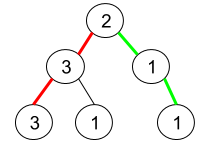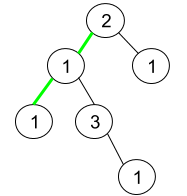Pseudo-Palindromic Paths in a Binary Tree
Given a binary tree where node values are digits from 1 to 9. A path in the binary tree is said to be pseudo-palindromic if at least one permutation of the node values in the path is a palindrome.
Return the number of pseudo-palindromic paths going from the root node to leaf nodes.
Example 1:

Input: root = [2,3,1,3,1,null,1] Output: 2 Explanation: The figure above represents the given binary tree. There are three paths going from the root node to leaf nodes: the red path [2,3,3], the green path [2,1,1], and the path [2,3,1]. Among these paths only red path and green path are pseudo-palindromic paths since the red path [2,3,3] can be rearranged in [3,2,3] (palindrome) and the green path [2,1,1] can be rearranged in [1,2,1] (palindrome).
Example 2:

Input: root = [2,1,1,1,3,null,null,null,null,null,1] Output: 1 Explanation: The figure above represents the given binary tree. There are three paths going from the root node to leaf nodes: the green path [2,1,1], the path [2,1,3,1], and the path [2,1]. Among these paths only the green path is pseudo-palindromic since [2,1,1] can be rearranged in [1,2,1] (palindrome).
Example 3:
Input: root = [9] Output: 1
Constraints:
- The given binary tree will have between 1 and 10^5 nodes.
- Node values are digits from 1 to 9.
Solution:
/**
* Definition for a binary tree node.
* public class TreeNode {
* int val;
* TreeNode left;
* TreeNode right;
* TreeNode() {}
* TreeNode(int val) { this.val = val; }
* TreeNode(int val, TreeNode left, TreeNode right) {
* this.val = val;
* this.left = left;
* this.right = right;
* }
* }
*/
class Solution {
int res = 0;
public int pseudoPalindromicPaths (TreeNode root) {
if (root == null) return res;
int[] count = new int[10];
pre(root, count);
return res;
}
private void pre(TreeNode root, int[] count) {
if (root == null) return;
count[root.val] ++;
if (root.left == null && root.right == null) {
// System.out.println(Arrays.toString(count));
boolean odd = false, isP = true;
for (int i = 1; i < 10; i ++) {
if (count[i] % 2 == 1) {
if (odd) {
isP = false;
break;
} else {
odd = true;
}
}
}
if (isP) {
res ++;
}
}
pre(root.left, count);
pre(root.right, count);
count[root.val] --;
}
}